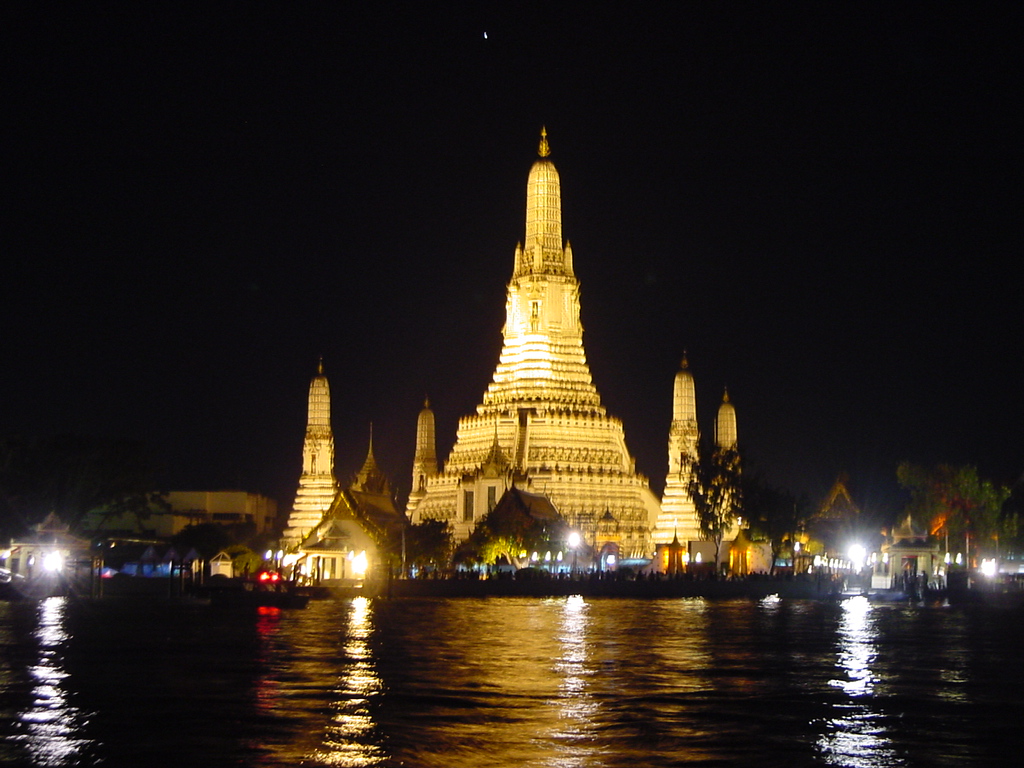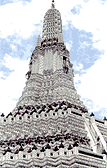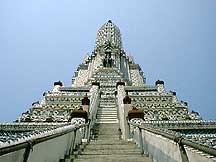Wat Arunrachawararam

Sailing down the Chao Phraya River and looking at the beautiful scenery along the river bank, one does not miss the impressive look of the magnificent 'Prang' (spire) of Wat Arun Rachawararam (or Wat Arun).The Prang is known as the symbol of Wat Arun and one of the most celebrated Bangkok landmarks.
Wat Arun Rachawararam, one of the major royal Thai temples,
stands gracefully on the west bank of the Chao Phraya River in the Wat Arun district, Bangkokyai, Bangkok. Surrounding Wat Arun are Taweetapisek School on the north, and the former palace (now the Thai Royal Navy Headquarters) on the south. On the east side it is also bordered by the Chao Phraya River, and Arunamarin Road on the west. Wat Arun was built during the height of the Ayutthaya period, and was originally called Wat Makok. The name has subsequently been changed to Wat Makoknok, Wat Chang (Temple of Dawn), Wat Arunrachataram, and finally Wat Arunrachawararam.The importance of Wat Arun is that it is considered the royal temple of King Rama II
because he was the one who restored it as crown prince. He was so deeply attached to this temple that he even sculptured the face of the main Buddha image by himself. Wat Arun is also one of the royal temples where the king of every reign goes every year to perform Kathin ceremony (a religious ceremony of presenting monastic robes to monks). In certain years the king travels to this temple by the magnificent Royal Barge Procession along the Chao Phraya River which is one of the most colourful and spectacular sights for foreign visitors.The main central Prang or spire, standing in front of the temple to the south, is the most outstanding architecture of the temple.
There is no evidence of what style or pattern the Prang is, except that it was built along with other temple buildings in the Ayutthaya period and it was 16 meters high at that time.


With his great faith, King Rama II determined to restore and enlarge the Prang which was intended to be the most remarkable gigantic spire of the city. Unfortunately, he passed away just after the construction area was located. Later in the reign of King Rama III, there was again a major restoration of Wat Arun, and many new buildings were built to be the monks' residence. Above all, to carry on his father's intention, King Rama III had the old main Prang restored and made it about 67 meters high.The base size of the main Prang is about 234 meters and it took nine years (1842-1851), in the reign of King Rama Ill, to complete it During the construction in 1946, the nine-tiered spire (called Nopasoon) was put on the top of the main Prang, and the crown brought from the main Buddha image in Wat Nang Nong was put on the top of Nopasoon. No sooner had the main Prang been completed than King Rama Ill passed away in 1851 even before there was any celebration of the Prang.
Once again, there was a major restoration of the Prang in the reign of King Rama V Fences were built around the Prang.
The base of the fences is built in white concrete and the top is made in red iron, of which each space is decorated with the figure of 'Garuda Catching Naga' (Garuda is a bird-like creature used as a vehicle of Narayana or Hindu God ; Naga is a snake-like creature in a myth). On the west side behind the Prang, there is an old Chinese style building of which the front part and the lower part of the roof are decorated with coloured porcelain. The yard around the Prang is covered with stone tiles and there are small stone statues in the shape of animals and Chinese soldiers standing guard surrounding the Prang. Altars are also set up in each corner inside the fence.The main Prang has many tiers and each tier has a terrace that forms the base of the Prang or the base of the next tier above. Around the Prang, there are steps that lead to each tier or each terrace floor. The Prang is encrusted with coloured porcelain painted in delicate flowers and leaves and at the top of each corner it is decorated with a porcelain vase of flowers. Above each corner are pavillions and above the pavillions are medium size spires (with Nopasoon and golden crown on the top) and the feature of Narayana riding on Garuda while catching Naga. Each layer of the Prang is supported by Kinnon and Kinnaree (the male and female half-bird and half-human figure), Yaksa (demon), monkeys, and Prom (a class celestial being in Hinduism and Buddhism).
The main Prang itself is made of concrete elaborately decorated with beautiful coloured porcelain. Some pieces of porcelain are mixed with the oyster shell and some are plain porcelain. The design on the porcelain is mostly of delicate flowers and leaves, but other decorative patterns are also used such as those found on chinaware. Sometimes some large ready made pieces of porcelain with patterns on them are used but sometimes small pieces are used to form the pattern.
Besides the main Prang, there are also four minor Prangs and Mondops (a square structure with four arches and a pyramidal roof) around the main Prang.
The four minor Prangs are all alike and they stand at the four corners of the main Prang base. One is on the northeast side, another is on the southeast, and the rest are on the northwest and the southwest corners. Mondops are on the second level in between the four Prangs.
The main temple building of Wat Arun was built in the reign of King Rama II. It is a fascinating work of art. On the four walls inside the temple building are valuable mural paintings. The main Buddha image named Praputtatammigarach Lokatatdilok is in the style of 'Pang Marnwichai' which represents the stage at which the Buddha could overcome the demon. It is said that the face of the main Buddha image was designed by King Rama II himself. Outside the temple are terraces on all four sides, and an entrance on each side. The Buddha images of the Pang Marnwichai style are situated on the terraces around the temple.
There is another temple building situated between the priests' residence and the Mondop or the shrine in which the imitation of the sacred Buddha s footprint is kept. The main Buddha image in this temple, called Praputtachampunut-Mahaburutlakana. Asitayanubopit, is also in the Pang Marnwichai style. At present, the temple is used as a place for sermons.
There are also many small temple buildings in front of the main Prang. These temples were originally built in the Ayutthaya period and they are now used as the entrance to the main Prang.
Apart from the ancient remains and religious structures mentioned above, many impressive things are also found at Wat Arun. First, the magnificent Mondop for keeping the sacred Buddha's footprint, stands in between the main temple and the four minor chedies or pagodas which stand in a row from east to west. Other interesting structures are two belfries and two towers which house the Buddhist scriptures ; one tower is near the pond and the other is on the north side. In front of Wat Arun, the reproduction of the mountain and the chinese style pavillion by the river and the dam create an impressive sight for visitors. All of these enchanting structures were built in the reigns of King Rama II and King Rama Ill.
In 1996 during the reign of King Rama IX, a monument was constructed in memory of King Rama II. The monument was built in front of Wat Arun, on the occasion of the golden jubilee of King Rama IX, a celebration of fifty years on his throne.
How can you get to Wat Arun ?
You can reach Wat Arun either by car, bus, or boat since Wat Arun is situated by the Chao Phraya River on one side and by Arunamarin Road on the other side. if you take the boat, board at Ta Tien near Wat pho. Should you decide to take a bus, bus number 19 or 57 can take you there. In addition, plenty of parking lots at the temple yard are available for those who want to drive their own cars.
Wat Arun, popularly known as Temple of Dawn,
is invaluable as work of Thai art and architecture. It is also well known among foreign visitors as one of the most notable landmarks of Thailand. Realizing how invaluable Wat Arun is, all Thai people have strong determination to continually take good care of it and keep it as the pride of the Country.Translator : Dr. Pornthip Krairussamee Ph.D
11 April 2000